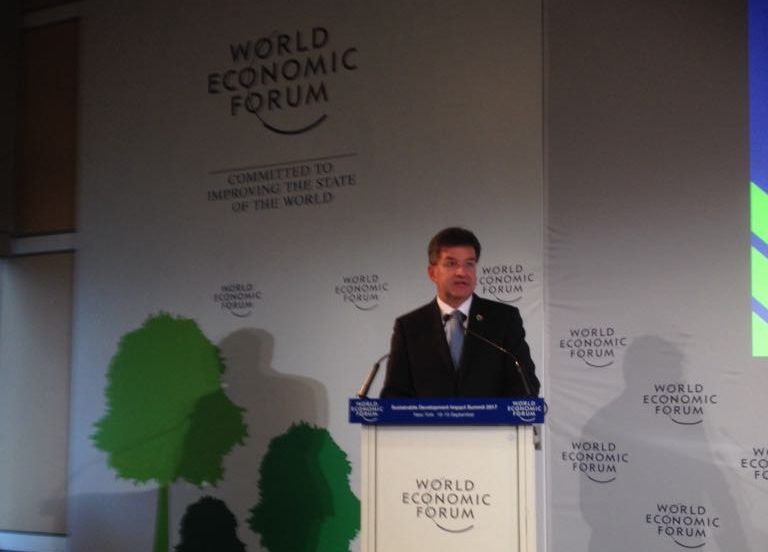World Economic Forum Sustainable Development Impact Summit

– As delivered –
Statement by H.E. Mr. Miroslav Lajčák, President of the 72nd Session of the UN General Assembly, at World Economic Forum Sustainable Development Impact Summit
Thank you for inviting me here today.
It seems very appropriate to discuss partnerships in this environment. The World Economic Forum is known for bringing together a wide mix of political leaders, policymakers, academics, business people and members of civil society.
The UN’s convening power is unparalleled (though the WEF comes very close!). They are also both in the business of using dialogue and debate to bring about collective action.
Last week I became President of the UN’s General Assembly. I’m here to give the UN perspective on partnerships.
I will address three main questions:
What did the 2030 Agenda mean for partnerships?
How far has this vision come to being realized?
What opportunities do we need to harness going forward?
And then I will run away because I’m only one week into this position and I don’t want to get any difficult questions from any of the experts out there.
We say it all the time but I want to stress it again today: the adoption of the 2030 Agenda for Sustainable Development really was a milestone. There were two main reasons for this:
One: It put that many issues on the UN’s agenda, which had traditionally only been discussed at national level. This was a formal acknowledgment that governments simply can’t go it alone if they want to see change.
Two: It drew a final line under the model created in 1945. Even though the UN was created exclusively by states, it now works for, and with, many different actors.
Partnerships come nicely packaged in SDG 17. They go beyond that however. They are at the core of the whole Sustainable Development Agenda. If we don’t make partnerships a part of our work on every Goal, we won’t achieve any of them.
There has been a stronger focus on partnerships since the SDGs were adopted.
The annual UN-Private Sector Forum is an example. It has generated some innovative ideas. This year’s meeting will be particularly important, as it will discuss financing the 2030 Agenda.
Some states and regional groups have developed new models. For example, the Small Island Developing States group created a Partnership Framework, which they use to monitor and follow-up on commitments related to cooperation.
UN offices and commissions have brought together a diverse range of actors at the regional-level.
We are also starting to see signs of success through financial partnerships between UN funds or programs, and financial institutions. The UN can act as an “investor of first resort” – particularly in post-conflict It can absorb some of the risk for entities such as the World Bank to come in, which can build private sector confidence and enhance stability.
The world is becoming more and more interconnected. Partnerships are growing in response. We now know that they are necessary to achieve the Sustainable Development Goals. But they are also forming in response to other global challenges.
This success, however, has been modest. We are still far off from seeing the kind of partnerships needed to achieve all 17 SDGs.
The UN is the biggest convening power in the world. It can bring actors from every corner of the world together. The big challenge facing it is moving beyond once-off events and discussions, to long-term partnerships.
We need to create platforms that can be upkept and sustained. Platforms that result in tangible decisions and products. We need to bring in the most cutting-edge technology, and the brightest innovators. We must bring in young people.
The world is becoming more and more interconnected. Partnerships are growing in response. We now know that they are necessary to achieve Sustainable Development Goals. But they are also forming in response to other global challenges. Smart phone apps are being used to connect refugees with internships in their new communities. NGOs are working with Governments to identify extremist content online to bring some examples.
The UN cannot be left behind. Its headquarters and field offices must act as breeding grounds for new kinds of partnerships. Meetings of only diplomats, or only UN officials must become a thing of the past.
It is clear we can’t do it alone. I am personally committed to encouraging a lot more people like you to come to that big glass building along the East River this year. (I might even offer a crash course in deciphering UN language – which I have had to take myself these past weeks)
So, let me thank you in advance for strengthened cooperation, and wish you luck in the rest of your discussions here today.